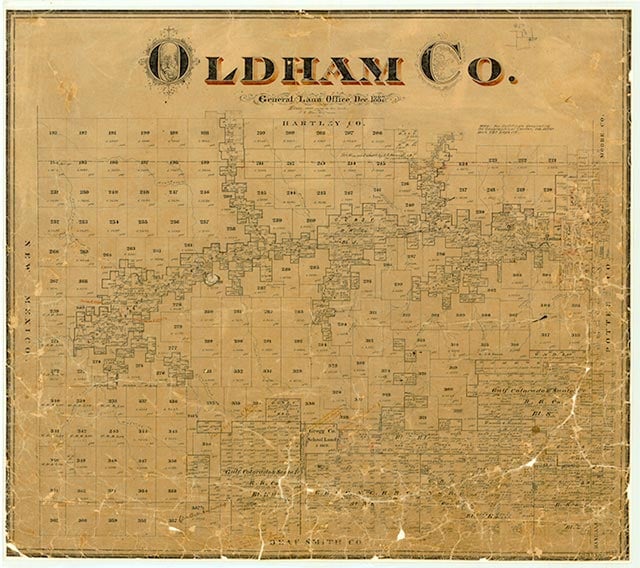Old Tascosa
Tascosa, on the Canadian River in northeastern Oldham County, was named for Atascosa (Spanish for "boggy") Creek, which flows into the river at the site of the original settlement. In 1876 the creek valley was first settled and was named Plaza Atascosa by Hispanic pastores under Casimero Romero. These sheepmen and freighters from New Mexico grazed their flocks and built adobe huts and irrigation ditches along the creeks in the area. Their settlement, 300 miles northwest of the line of settlements in 1875, and on the cattle trail through the Panhandle to Dodge City (see TASCOSA-DODGE CITY TRAIL), was on the Canadian River at the site of an easy ford for cattle and freight. Romero and most of his followers remained in the vicinity until the late 1880s and 1890s, when most of them drifted with their sheep back to New Mexico. The few who remained switched to cattle. After 1875 large ranches dominated the area, and Tascosa became the shipping and supply point for the LIT, LX, LS, Frying Pan, and XIT ranches. Henry Kimball, the first Anglo settler in the Tascosa area, set up his blacksmith shop in 1876. A general store and saloon were also established. Before a post office was opened at Tascosa, "Dad" Barnes carried the town's mail to Dodge City. With the organization of Oldham County in 1880, Tascosa became the county seat. Saloons and dance halls sprang up, and a stone courthouse was built. Caleb Berg (Cape) Willingham , the first sheriff of the county, shot the man who occupied the first grave in Boot Hill Cemetery. As the Cowboy Capital of the Plains, Tascosa had more than its share of conflicts settled by fast guns. Noted outlaws, including Henry McCarty (Billy the Kid) and Dave Rudabaugh, walked its streets, as did lawmen Pat Garrett, Charles A. Siringo, and others. Conflicts developed on the large ranches in 1883, when Tascosa became the scene of an unsuccessful cowboys' strike for higher wages. Charles Francis Rudolph began a weekly newspaper, the Tascosa Pioneer, in the summer of 1886.
In 1887 the Fort Worth and Denver City Railway constructed sixteen miles of track across the northeastern corner of Oldham County. Many of the businesses from Tascosa moved two miles to a new site on the railroad and across the Canadian. By 1890 the combined population of the two settlements was 350. As new towns were established throughout the Panhandle, Tascosa declined steadily. When an election moved the county seat to Vega in 1915, only fifteen persons remained at Tascosa. The site of old Tascosa was entirely deserted when Frenchy McCormick, widow of the town's first saloon owner, Mickey McCormick, moved to Channing in 1939. In June 1939, however, Cal Farley established his Maverick Boys' Ranch at the old townsite, offering a home and training to underprivileged boys (see CAL FARLEY'S BOYS RANCH). The newer Tascosa, on the railroad, had two stores and a population of fifty in 1947. In the 1980s the stone courthouse at old Tascosa housed a museum, and Boothill Cemetery remained as a reminder of the wild days. A reconstruction of Tascosa's original school was being used by the boys' ranch. At that time the Tascosa on the railroad was a supply point for area ranching and agriculture. In 1990 the boys' ranch had a population of 485, and new Tascosa consisted of a siding and a stock pen.
| © TSHA

Adapted from the official Handbook of Texas, a state encyclopedia developed by Texas State Historical Association (TSHA). It is an authoritative source of trusted historical records.

- ✅ Adoption Status:
Belongs to
Old Tascosa is part of or belongs to the following places:
Currently Exists
No
Place type
Old Tascosa is classified as a Town
Associated Names
- (Boys Ranch)
Location
Latitude: 35.53143600Longitude: -102.25408410
Has Post Office
No
Is Incorporated
No

